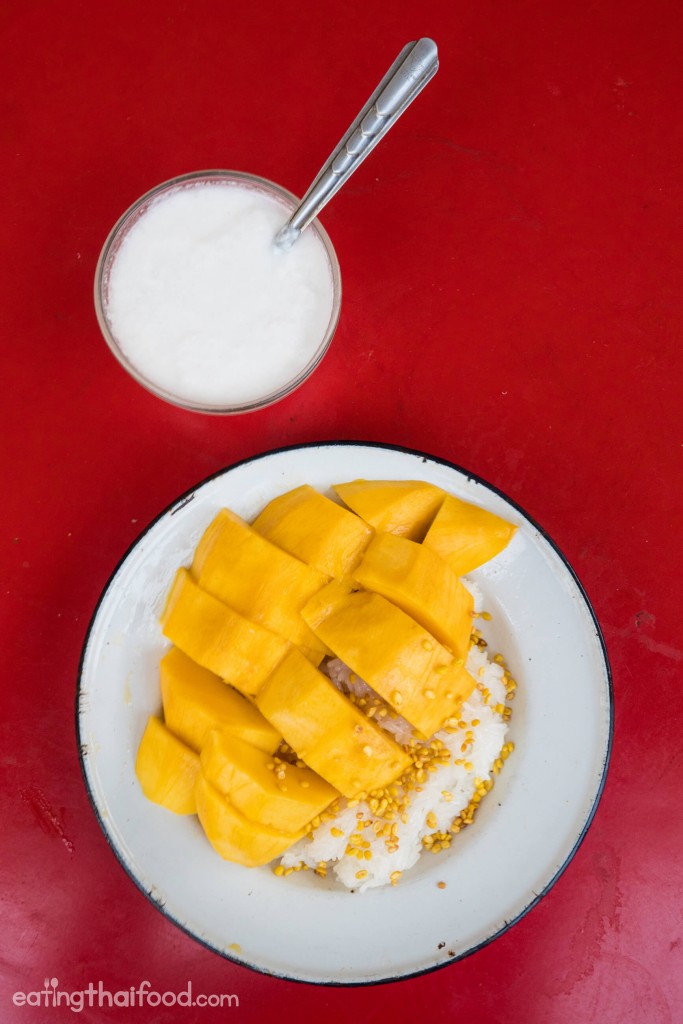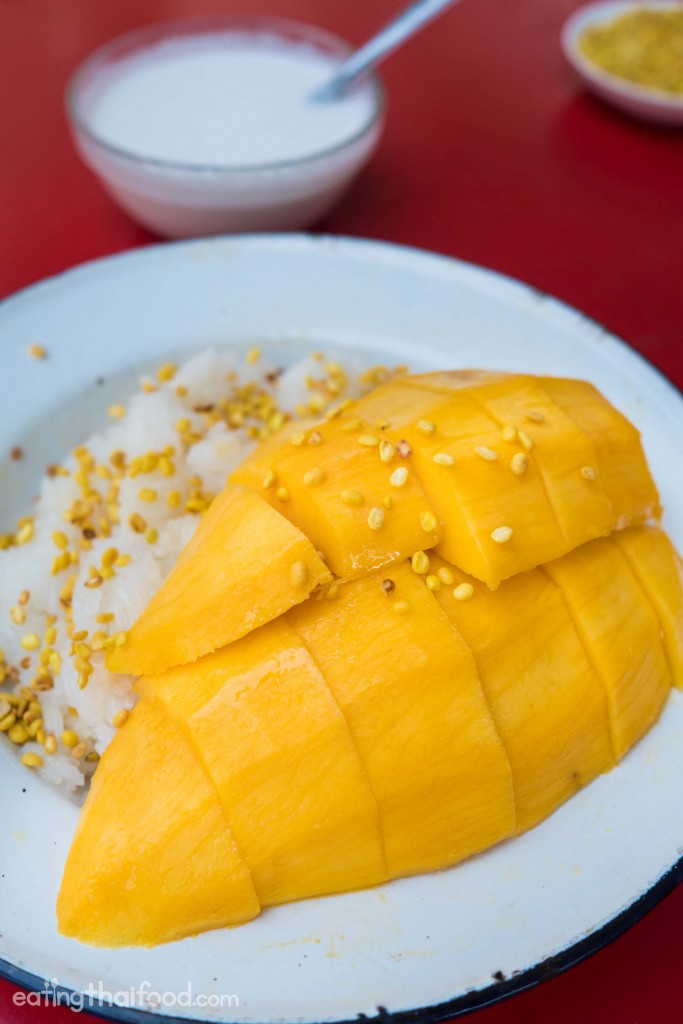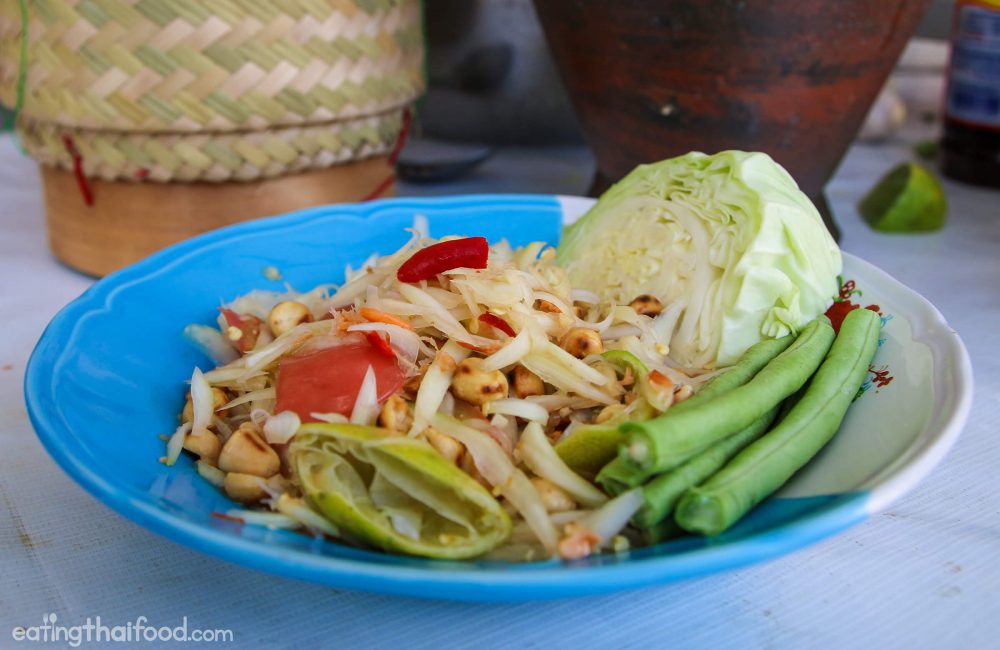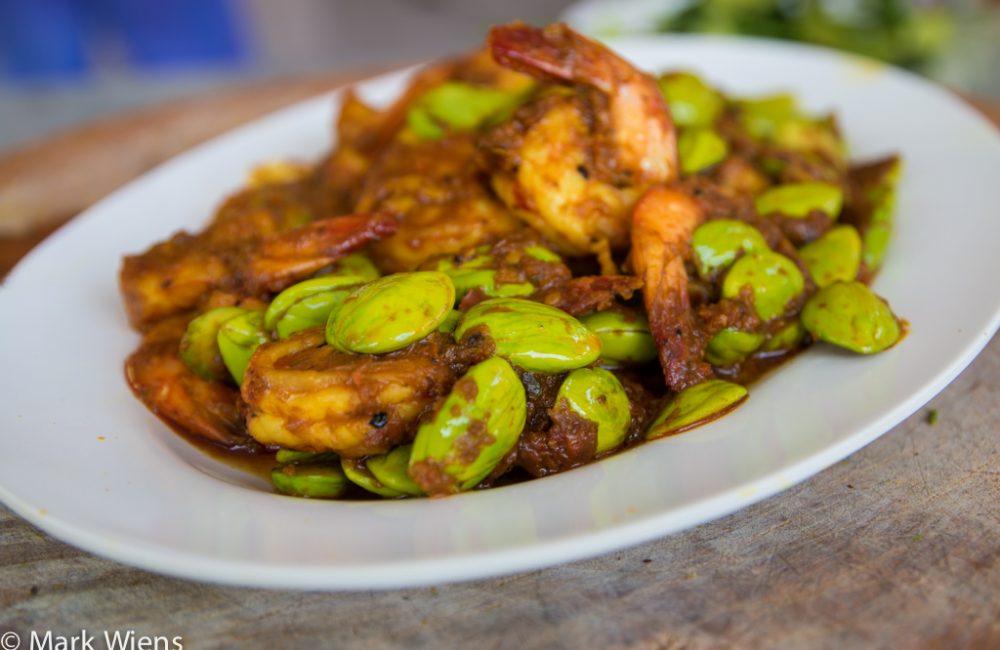Thai Mango Sticky Rice Recipe: Authentic Thai Street Food Style!
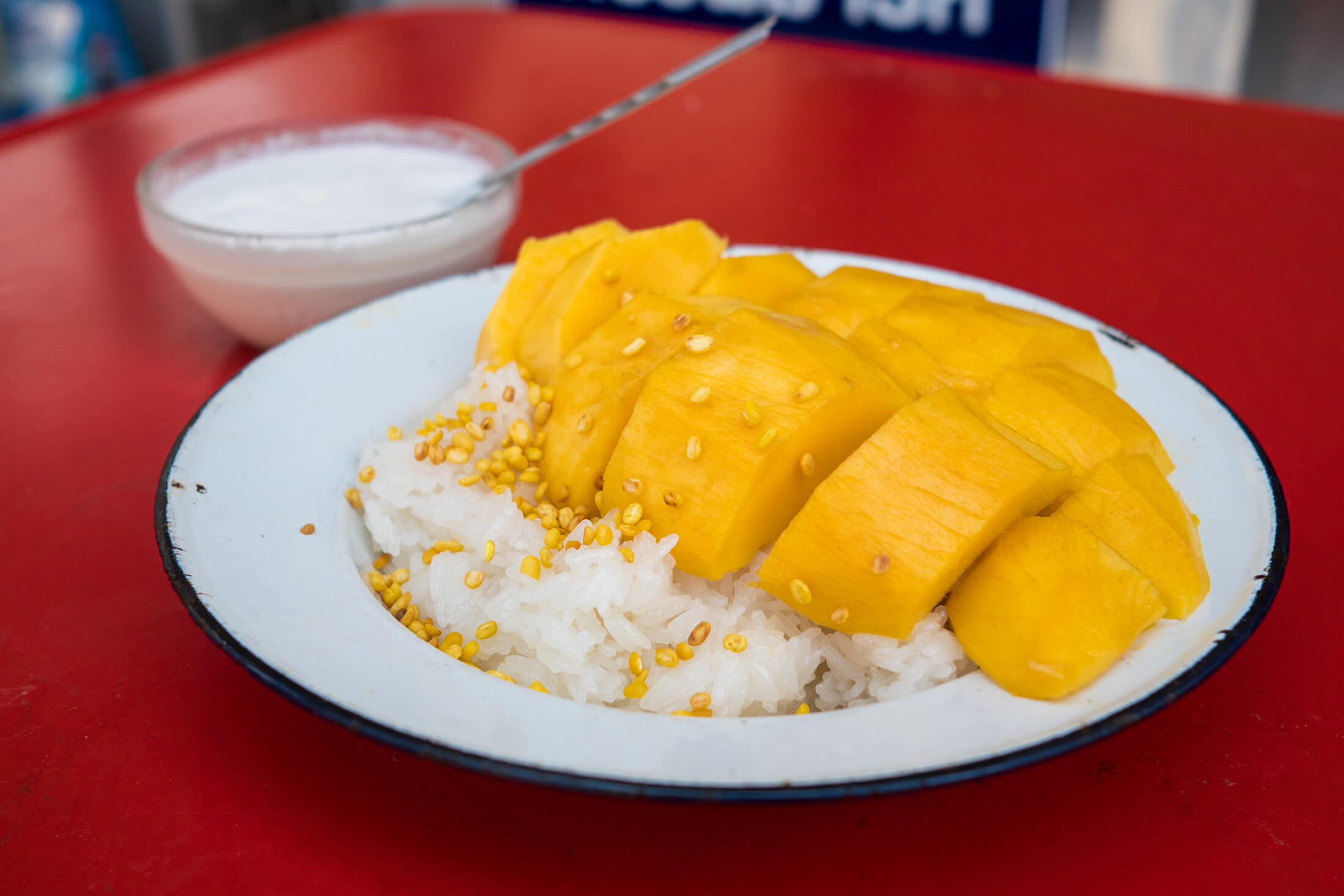
In this Thai mango sticky rice recipe, you’ll learn how to make authentic Thai street food style coconut sticky rice with mango.
Let’s get started making this recipe!
- Mango, sticky rice, coconut cream
- Juicy mango!
What is Thai mango sticky rice?
NOTE: If you want to get straight into the recipe as fast as possible, scroll down to the video and recipe box below. But for a more in-depth explanation about this Thai dessert, keep reading this entire post.
In Thai it’s called khao neow mamuang (ข้าวเหนียวมะม่วง), khao neow (ข้าวเหนียว) means glutinous sticky rice, while mamuang (มะม่วง) means mango in Thai.
Within Thai cooking, sticky rice is the staple starch of northern and northeastern Thai cuisine (Isaan), and it’s also commonly used in all sorts of Thai desserts.
For Thai mango sticky rice, the sticky rice is steamed, mixed with thick coconut cream and sugar, paired with perfectly ripe yellow sweet mango, served with some extra coconut cream on the top to make it even better, and finally often some crispy yellow mung beans are sprinkled on the very top.

Ingredients for khao neow mamuang
Ingredients you’ll need:
For the sticky rice
- 1 kg. Thai sticky rice (ข้าวเหนียว)
- 800 ml. coconut cream (หัวกะทิ) – If you can’t get fresh coconut milk, this is my favorite type in the box.
- 150 g. sugar (น้ำตาลทราย)
- 1 tsp. salt (เกลือ)
For the mango
- Sweet yellow mangoes (มะม่วงนำ้ดอกไม้)
- 100 g. yellow mung beans (ถั่วเหลือง) – optional
For the coconut cream topping
- 200 ml. coconut cream (หัวกะทิ)
- 1/3 tsp. salt (เกลือ)
Really good quality coconut cream (or canned or box coconut milk) and really juicy sweet mangoes are the key to making this Thai mango sticky rice recipe.

Start with the sticky rice
Sticky rice
Thai sticky rice sweetened with sugar and coconut cream is a popular base for many different Thai desserts, and it’s highly important for this mango sticky rice recipe.
If you have an Asian supermarket available, look for Thai sticky rice, or Thai glutinous rice, or sometimes it’s called Thai sweet rice (it’s much different from regular jasmine rice, and different from Chinese sweet rice).
To make sticky rice, you can use my Thai sticky rice recipe. However you’ll want to pre-rinse it even more thoroughly to remove all the outer starch on each grain of rice before steaming it.

Soak and wash the rice thoroughly to remove all starch
I washed the rice about 6 times to begin with, lightly rubbing the rice together to scratch off most of the starch. And then I allowed the rice to soak in water for 6 hours. This is the one step where it’s best to think ahead before you start this mango sticky rice recipe so you have time to soak the rice.
Once you’ve rinsed the rice six times, when you add water again, the water should be clear, not milky from the starch. If it’s milky, rinse it a few more times.
Once your sticky rice has soaked for about 6 hours, drain it, and it’s time to steam it.
You can use any kind of steaming method you’d like, but just make sure the sticky rice is placed somewhere above steam in a pot, and covered.
I used the Thai / Laos traditional basket steamer and steamed the sticky rice for about 15 minutes.

Coconut cream
While your sticky rice is steaming, you can get started on the coconut cream sugar mixture.
For this recipe you’re only going to want to use coconut cream, which in Thai is called hua kati (หัวกะทิ). It’s the richest and most butter thick coconut milk, so it’s higher in fat and just an amazing thing.

Heat the coconut cream
In a medium sized sauce pan, add 800 ml. of the coconut cream, and stir it in circular motions, just in one direction (make sure you just stir in one direction or the coconut cream could start to curdle).
Immediately add 150 g. sugar, and 1 tsp. of salt, and keep stirring gently on the heat, making sure the sugar completely dissolves.
As soon as the coconut cream comes to a boil and the sugar is fully dissolved, turn off the heat.

Mix the coconut cream with the hot steamed sticky rice
Your sticky rice should still be steaming hot, and dump the whole lump of sticky rice into a heat proof mixing bowl.
Take the coconut cream sugar mixture, and start by first adding a couple spoons and delicately mixing it into the sticky rice.
Keep adding more spoons (spoon by spoon) and stirring, but you want to gradually add the coconut cream so that it remains sticky but doesn’t get mushy.

Keep stirring, adding the coconut cream slowly
You’ll use all the coconut cream, but add it little by little and mix, until it’s all soaked up by the sticky rice.
When you’re finished, you should almost have a sticky grain pudding like texture, and the rice should be shining and glistening because of all that healthy coconut fat.
At this point the sticky rice is already to be eaten, make sure you taste test it, it should be a bit sweet, and very rich and coconut-y tasting, with just a hint of a saltiness to bring out the taste of everything.

Cover your sticky rice or it will get crusty
When you make this mango sticky rice recipe, if you’re not planning to eat the sticky rice immediately, it’s best to cover it in a plastic bag or plastic wrap so that it doesn’t get dried out or crusty.
Normally in Thailand this type of sticky rice is not refrigerated or it will damage the texture and taste, so it’s usually eaten within a few hours of being prepared. It will still work to refrigerate it, but it won’t be nearly as good.

Mung beans for topping
Toppings
Finally, these are both optional, but they are commonly accompanied with mango sticky rice in Thailand: extra coconut cream and crispy mung beans.
For the extra coconut cream, take the remaining 200 ml. of coconut cream, put in a pot on medium heat, add a pinch of salt, and stir gently until it boils. Then put into a bowl to serve alongside your sticky rice mango.
For the yellow mung beans (you buy yellow mung daal), put a wok or frying pan on the stove on low heat, and dry fry the mung beans for a few minutes, stirring them continuously until they start to turn slightly golden and get more crispy.

Let’s quickly talk about Thai mangoes
Mangoes
Mango sticky rice wouldn’t be complete without mango, and for this mango sticky rice recipe you’ll need perfectly ripe mangoes that are silky in texture (not the stringy mangoes).
In Thailand there are a number of varieties of mango used for khao neow mamuang (ข้าวเหนียวมะม่วง), but one of the most common is called mamuang nam dokmai (มะม่วงนำ้ดอกไม้) – literally translated to flower water mango.

Peel the mango and slice it into bite sizes strips
When it comes to Thai food and specifically Thai desserts, presentation and beauty are hugely important.
And so vendors that sell mangoes or serve mango sticky rice take ultimate care in their mangoes, making sure they are not bruised, but are beautiful and yellow.
Most of the time in Thailand, the mango is peeled from the stem side, slicing off long strands of the skin towards the pointy end. Once the first half is peeled, it’s then sliced off the seed, so you’re left with a mango steak from one side of the mango, and that’s then cut into big bite sizes slices (might be easier explained in the video below).

Assemble your mango sticky rice
Combining it all
Once you have all your components for this Thai mango sticky rice recipe ready, it’s time to dish out a plate.
Put some coconut sticky rice down on the base of a plate or bowl, slice on a fresh mango, sprinkle on some crispy mung beans, and finally serve the extra coconut cream on the side.
The recipe for sticky rice might make in total about 10 – 15 portions, and you can really add as much or little mango to each plate as you have, or as you like.

Mango sticky rice recipe (ข้าวเหนียวมะม่วง)
Mango sticky rice recipe (วิธีทำ ข้าวเหนียวมะม่วง)
If you have a few minutes, first watch the video below:
(Or watch it on YouTube here: https://youtu.be/H_R108b6ZQg)
Time: The sticky rice is best soaked in water for about 6 hours, but after that, this recipe only takes about 30 minutes to make.
Recipe size: The rice makes about 10 – 15 portions, and it would probably be best to use about 1/2 mango per portion
Cooking utensils: Steamer, pot, wok / frying pan
Flavors: Sweet
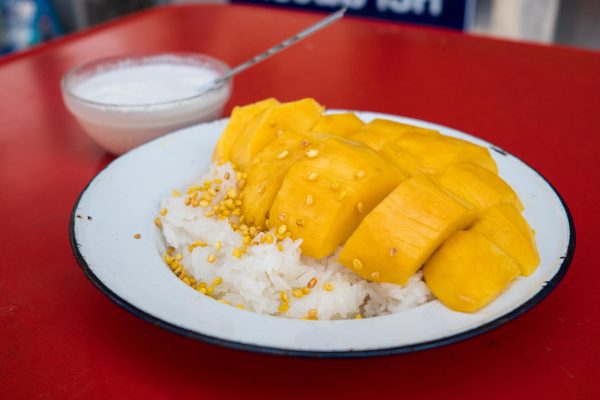
- 1 kg. Thai sticky rice (ข้าวเหนียว)
- 800 ml. coconut cream (หัวกะทิ)
- 150 g. sugar (น้ำตาลทราย)
- 1 tsp. salt (เกลือ)
- 200 ml. coconut cream (หัวกะทิ)
- ⅓ tsp. salt (เกลือ)
- Sweet yellow mangoes (มะม่วงนำ้ดอกไม้)
- 100 g. yellow mung beans (ถั่วเหลือง)
- Rinse the sticky rice 6 - 10 times, making sure most of the starch gets removed and you're left with clear water. Then soak the rice submerged in water for about 6 hours.
- Using a steamer basket or other type of steamer, steam the sticky rice for about 15 minutes until fully cooked, then set aside.
- In a pot, add 800 ml. coconut cream on medium heat, and stir in one circular direction gentry. Add 150 g. sugar and 1 tsp. salt, and keep stirring and cooking until fully dissolved. When the coconut cream mixture comes to a boil, turn off the heat.
- Put the fresh sticky rice into a mixing bowl, and begin to slowly add in the coconut cream and sugar mixture. You'll combine all of it, but add it spoon by spoon and work it slowly into the rice. Once all combined you should be left with shimmering sticky rice that's almost a grainy pudding in texture. Your sticky rice is ready, cover it with plaster so it doesn't get crusty.
- In a separate sauce pan add the other portion of coconut cream and salt, and stir on low heat. Bring it to a boil, then turn off the heat, and set aside in a bowl. This will be served alongside the mango sticky rice as a topping.
- In a wok or frying pan, using low heat, dry fry the yellow mung beans for a few minutes until they turn golden crispy. Again, set this aside as a topping.
- For the mango, first peel the skin, then cut off the meat from either side of the mango seed, and slice the mango into large bite sized pieces.
- On a plate, first add a portion of sticky rice, top it with mango, sprinkle on some mung beans, and serve the extra coconut cream on the side.
- Enjoy!

Thai mango sticky rice!
Conclusion
Khao neow mamuang (ข้าวเหนียวมะม่วง), yellow juicy mango with sweet coconut sticky rice, is one of the most incredible Thai desserts.
When it’s mango season in Thailand, you’ll find delicious ripe mangoes all over Bangkok, and you’ll discover countless street food carts and stalls at markets that sell sticky rice and mango.
If you can get some ripe yellow mangoes, sticky rice, and coconut cream, you can make this authentic Thai mango sticky rice recipe at home!
Let me know if you have any questions in the comments below.
Also, be sure to check out more authentic recipes here.

